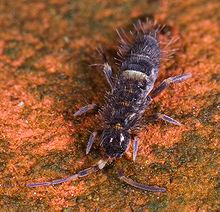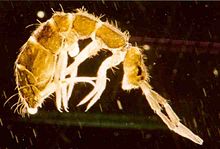Springtail
| Springtails Temporal range:
| |
|---|---|

| |
| Orchesella cincta | |
| Scientific classification | |
| Domain: | Eukaryota |
| Kingdom: | Animalia |
| Phylum: | Arthropoda |
| Clade: | Pancrustacea |
| Subphylum: | Hexapoda |
| Subclass: | Collembola Lubbock, 1871 |
| Orders | |
| |
| Synonyms[1] | |
| |
Springtails (Collembola) form the largest of the three lineages of modern hexapods that are no longer considered insects (the other two are the Protura and Diplura). Although the three orders are sometimes grouped together in a class called Entognatha because they have internal mouthparts, they do not appear to be any more closely related to one another than they are to all insects, which have external mouthparts.
Collembolans are
Some
Morphology


Members of the Collembola are normally less than 6 mm (0.24 in) long, have six or fewer
Springtails also possess the ability to reduce their body size by as much as 30% through subsequent
The
Poduromorphs are characterized by their elongated bodies and conspicuous segmentation – three thoracic segments, six abdominal segments, including a well-developed prothorax with tergal chaetae,[17] while the first thoracic segment in Entomobryomorpha is clearly reduced and bears no chaetae.
The digestive tract of collembolan species consists of three main components: the foregut, midgut, and hindgut. The midgut is surrounded by a network of muscles and lined with a monolayer of columnar or cuboidal cells. Its function is to mix and transport food from the lumen into the hindgut through contraction. Many species of syntrophic bacteria, archaea, and fungi are present in the lumen. These different digestive regions have varying pH to support specific enzymatic activities and microbial populations. The anterior portion of the midgut and hindgut is slightly acidic (with a pH of approximately 6.0) while the posterior midgut portion is slightly alkaline (with a pH of approximately 8.0). Between the midgut and hindgut is an alimentary canal called the pyloric region, which is a muscular sphincter.[11] Malpighian tubules are absent.[18]
Systematics and evolution
Traditionally, the springtails were divided into the
The term "Neopleona" is essentially synonymous with Symphypleona + Neelipleona.
The latest whole-genome phylogeny supporting four orders of Collembola:[21]
Springtails are attested to since the
Fossil Collembola are rare. Instead, most are found in amber.[26] Even these are rare and many amber deposits carry few or no collembola. The best deposits are from the early Eocene of Canada and Europe,[27] Miocene of Central America,[28] and the mid-Cretaceous of Burma and Canada.[29] They display some unexplained characteristics: first, all but one of the fossils from the Cretaceous belong to extinct genera, whereas none of the specimens from the Eocene or the Miocene are of extinct genera; second, the species from Burma are more similar to the modern fauna of Canada than are the Canadian Cretaceous specimens.
There are about 3,600 different species.[30]
Ecology
Eating behavior
Specific feeding strategies and mechanisms are employed to match specific niches.[31] Herbivorous and detritivorous species fragment biological material present in soil and leaf litter, supporting decomposition and increasing the availability of nutrients for various species of microbes and fungi.[32] Carnivorous species maintain populations of small invertebrates such as nematodes, rotifers, and other collembolan species.[11][15] Springtails commonly consume fungal hyphae and spores, but also have been found to consume plant material and pollen, animal remains, colloidal materials, minerals and bacteria.[33]
Predators
Springtails are consumed by mesostigmatan mites in various families, including Ascidae, Laelapidae, Parasitidae, Rhodacaridae and Veigaiidae.[34]
Cave-dwelling springtails are a food source for spiders and harvestmen in the same environment, such as the endangered harvestman Texella reyesi.[35]
To protect themselves, some species have evolved chemical defenses.[36]
Distribution
Springtails are

In sheer numbers, they are reputed to be one of the most abundant of all macroscopic animals, with estimates of 100,000 individuals per square meter of ground,
In addition, a few species routinely climb trees and form a dominant component of canopy fauna, where they may be collected by beating or insecticide fogging.[43][44] These tend to be the larger (>2 mm) species, mainly in the genera Entomobrya and Orchesella, though the densities on a per square meter basis are typically 1–2 orders of magnitude lower than soil populations of the same species. In temperate regions, a few species (e.g. Anurophorus spp., Entomobrya albocincta, Xenylla xavieri, Hypogastrura arborea) are almost exclusively arboreal.[41] In tropical regions a single square meter of canopy habitat can support many species of Collembola.[12]
The main

As a group, springtails are highly sensitive to

The horizontal distribution of springtail species is affected by environmental factors which act at the landscape scale, such as soil
In a variegated landscape, made of a patchwork of closed (
Relationship with humans

Springtails are well known as
Various sources and publications have suggested that some springtails may
In 1952,
Captive springtails are often kept in a terrarium as part of a clean-up crew.[87]
Ecotoxicology laboratory animals
Springtails are currently used in laboratory tests for the early detection of
Collembola have been found to be useful as bio-indicators of soil quality. Laboratory studies have been conducted that validated that the jumping ability of springtails can be used to evaluate the soil quality of Cu- and Ni-polluted sites.[97]
Climate warming impact
In polar regions that are expected to experience among the most rapid impact from climate warming, springtails have shown contrasting responses to warming in experimental warming studies.[98] There are negative,[99][100] positive[101][102] and neutral responses reported.[100][103] Neutral responses to experimental warming have also been reported in studies of non-polar regions.[104] The importance of soil moisture has been demonstrated in experiments using infrared heating in an alpine meadow, which had a negative effect on mesofauna biomass and diversity in drier parts and a positive effect in moist sub-areas.[105] Furthermore, a study with 20 years of experimental warming in three contrasting plant communities found that small scale heterogeneity may buffer springtails to potential climate warming.[103]
Reproduction
See also
References
- ISBN 978-0-306-44967-3.
- OCLC 276340542.
- PMID 9647845.
- ^ Lubbock, John (1873). Monograph of the Collembola and Thysanura. London: Ray Society. p. 36.
- S2CID 38792657.
- S2CID 43942720.
- S2CID 82407120.
- ^ S2CID 10783597.
- PMID 16290034.
- ^ .
- ^ a b c d e Hopkin, Stephen P. (1997). Biology of the springtails (Insecta: Collembola). Oxford: Oxford University Press.
- ^ OCLC 124074839.
- .
- ^ Multicellular Animals: Volume II: The Phylogenetic System of the Metazoa
- ^ ISBN 978-0-12-415955-6.
- .
- ^ S2CID 214349457.
- ^ Water and ion transport across the eversible vesicles in the collophore of the springtail Orchesella cincta
- PMID 18835455.
- ^ hdl:11365/1079696.
- ^ S2CID 211133755.
- ^ "Checklist of the Collembola". Retrieved January 2, 2016.
- S2CID 88641582.
- OCLC 925231875.
- ^ "Hexapoda. Insects, springtails, diplurans, and proturans". Tree of Life Web Project. January 1, 2002. Retrieved March 26, 2017.
- ^ Mari Mutt, José A. (1983). "Collembola in amber from the Dominican Republic" (PDF). Proceedings of the Entomological Society of Washington. 85 (3): 575–587.
- PDF). Geologica Acta. 2 (1): 3–8.
- PMID 23082186.
- .
- ^ Koehler, Philip G.; Aparicio, M. L. & Pfiester, Margaret (July 2011). "Springtails" (PDF). Gainesville, Florida: University of Florida IFAS Extension. Retrieved March 26, 2017.
- .
- S2CID 22883809.
- PDF). Pedobiologia. 40 (2): 149–161.
- ISBN 978-0-444-50019-9.
- ^ City of Austin and Travis County (September 3, 2020). "Support for Maintaining Endangered Status For the Bone Cave Harvestman (Texella reyesi)". Retrieved October 6, 2022.
- ^ Insect Molecular Biology and Ecology
- ^ a b Hopkin, Stephen P. (1997). "The biology of the Collembola (springtails): the most abundant insects in the world" (PDF). Natural History Museum. Retrieved January 2, 2016.
- .
- ^ ISBN 978-0-19-158925-6.
- doi:10.1139/x97-169.
- ^ a b c d e Ponge, Jean-François (1993). "Biocenoses of Collembola in atlantic temperate grass-woodland ecosystems". Pedobiologia. 37 (4).
- JSTOR 2424550.
- .
- .
- ^ S2CID 258140448.
- S2CID 85133291.
- S2CID 258572651.
- .
- S2CID 14442664.
- PMID 24035747.
- .
- S2CID 914560.
- S2CID 86619537.
- .
- S2CID 41604935.
- ^ Wilson, Jane M. (1982). "A review of world Troglopedetini (Insecta, Collembola, Paronellidae), including an identification table and descriptions of new species" (PDF). Cave Science: Transactions of the British Cave Research Association. 9 (3): 210–226.
- .
- hdl:10171/27607.
- .
- S2CID 84523833.
- ^ Faber, Jack H. & Joosse, Els N.G. (1993). "Vertical distribution of Collembola in a Pinus nigra organic soil". Pedobiologia. 37 (6): 336–350.
- PDF). Belgian Journal of Zoology. 130 (Supplement 1): 57–61.
- ^ "Isotomurus palustris (Muller, 1776)". Retrieved April 2, 2017.
- ^ Identification and Ecology of Freshwater Arthropods in the Mediterranean Basin
- ^ Pichard, Sylvain (1973). "Contribution à l'étude de la biologie de Podura aquatica (Linné) Collembole". Bulletin Biologique de la France et de la Belgique (in French). 107 (4): 291–299.
- ^ Aquatic Insects: Behavior and Ecology
- S2CID 86289373.
- .
- S2CID 86558143.
- .
- .
- .
- State of Victoria. 2017. Retrieved June 2, 2018.
- .
- S2CID 11014525.
- S2CID 9273050.
- .
- ^ Ponge, Jean-François; Charpentié, Marie-José (1981). "Étude des relations microflore-microfaune: expériences sur Pseudosinella alba (Packard), Collembole mycophage". Revue d'Écologie et de Biologie du Sol. 18 (3): 291–303.
- .
- ^ a b Janssens, Frans & Christiansen, Kenneth A. (November 22, 2007). "Synanthropic Collembola, springtails in association with Man". Checklist of the Collembola. Retrieved April 9, 2017.
- .
- S2CID 83870937.
- PMID 19611235.
- S2CID 6473251.
- ^ "Insects as Biological Weapons - Insects, Disease, and History | Montana State University". www.montana.edu. Retrieved 2022-10-06.
- ISBN 978-0-19-533305-3.
- ^ "The Top 5 Bioactive Clean Up Crew". Northampton Reptile Centre. 16 December 2015. Retrieved 6 July 2021.
- PMID 11222037.
- ^ ISO 11267 (2014). "Soil quality. Inhibition of reproduction of Collembola (Folsomia candida) by soil contaminants". Geneva: International Organization for Standardization.
{{cite web}}: CS1 maint: numeric names: authors list (link) - ^ Krogh, Paul Henning (August 1, 2008). "Toxicity testing with the collembolans Folsomia fimetaria and Folsomia candida and the results of a ringtest" (PDF). Retrieved April 17, 2017.
- .
- ^ ISO 17512-2 (2011). "Soil quality. Avoidance test for determining the quality of soils and effects of chemicals on behaviour. Part 2: Test with collembolans (Folsomia candida)". Geneva: International Organization for Standardization.
{{cite web}}: CS1 maint: numeric names: authors list (link) - .
- .
- PMID 19031917.
- PMID 19457238.
- .
- PMID 23278945.
- S2CID 13826340.
- ^ .
- .
- S2CID 36287733.
- ^ PMID 26670681.
- .
- .
- .
- S2CID 12056710.
- .
- PMID 14686939.
- S2CID 8585323.
- PMID 16701248.
External links
- . Encyclopædia Britannica. Vol. 25 (11th ed.). 1911.
- Checklist of the Collembola of the World
- Summary information about the distribution and ecology of Collembola (springtails) in the UK and Ireland
- General information on Collembola
- General information on Collembola
- A small lecture from Steve Hopkin
- General information on Collembola, with many macrophotographs from Dutch springtails
- Collembola species currently recorded from South Africa

